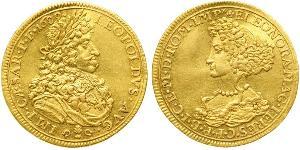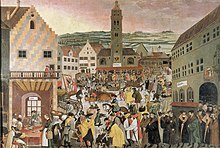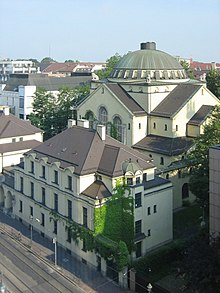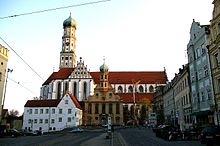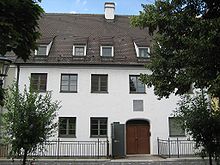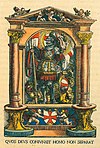| preceded by | |
|
|||||||
|
|
|||||||
| succeeded by |
| Imperial City of Augsburg (1276 - 1803)from the Wikipedia | Read original article |
| Augsburg | ||
|---|---|---|

View of Augsburg City Hall and other historical buildings in Augsburg
|
||
|
||
| Coordinates: 48°22′N 10°54′E / 48.367°N 10.900°ECoordinates: 48°22′N 10°54′E / 48.367°N 10.900°E | ||
| Country | Germany | |
| State | Bavaria | |
| Admin. region | Schwaben | |
| District | Urban district | |
| Government | ||
| • Lord Mayor | Kurt Gribl (CSU) | |
| Area | ||
| • Total | 146.93 km2 (56.73 sq mi) | |
| Elevation | 495 m (1,624 ft) | |
| Population (2013-12-31)[1] | ||
| • Total | 276,542 | |
| • Density | 1,900/km2 (4,900/sq mi) | |
| Time zone | CET/CEST (UTC+1/+2) | |
| Postal codes | 86150–86199 | |
| Dialling codes | 0821 | |
| Vehicle registration | A | |
| Mixed Imperial City of Augsburg | |||||
| Paritätische Reichsstadt Augsburg | |||||
| Free Imperial City of the Holy Roman Empire | |||||
|
|||||
| Capital | Augsburg | ||||
| Government | Republic | ||||
| Historical era | Middle Ages | ||||
| - | Bishopric established | 4th century | |||
| - | Bishopric gained Imperial immediacy |
c. 888 | |||
| - | City gained immediacy | 1276 | |||
| - | Diet of Augsburg: Confessio Augustana |
1530 | |||
| - | Joined Schmalkadic League | 1537 | |||
| - | Peace of Augsburg | 1555 | |||
| - | Occupied by Sweden | 1632–35 | |||
| - | Mediatised to Bavaria | 1803 | |||
Augsburg (German pronunciation: [ˈʔaʊ̯ksbʊʁk] (![]() listen)) is a city in the south-west of Bavaria, Germany. It was a Free Imperial City for over 500 years.
listen)) is a city in the south-west of Bavaria, Germany. It was a Free Imperial City for over 500 years.
It is a university town and home of the Regierungsbezirk Schwaben and the Bezirk Schwaben. Augsburg is an urban district and home to the institutions of the Landkreis Augsburg. It is the third-largest city in Bavaria (after Munich and Nuremberg) with a population of 284,000 citizens.[2] After Neuss and Trier, Augsburg is Germany's third oldest city, being founded by the Romans as Augusta Vindelicorum, named after the Roman emperor Augustus.
Augsburg is the only German city with its own legal holiday, the Augsburger Hohes Friedensfest, celebrated on August 8 of every year. This gives Augsburg more legal holidays than any other region or city in Germany.[3]
Augsburg was the home of two patrician families that rose to great prominence internationally, replacing the Medicis as Europe's leading bankers, the Fugger and the Welser families.
Contents
Geography[edit]
Augsburg lies at the convergence of the Alpine rivers Lech and Wertach and on the Singold. The oldest part of the city and the southern quarters are on the northern foothills of a high terrace, which emerged between the steep rim of the hills of Friedberg in the east and the high hills of the west. In the south extends the Lechfeld, a Outwash plain of the post ice age between the rivers Lech and Wertach, where rare primeval landscapes were preserved. The Augsburg city forest and the Lech valley heaths today rank among the most species rich middle European habitats.[citation needed]
On Augsburg borders the nature park Augsburg Western Woods - a large forestland. The city itself is also heavily greened. Because of that the city won in the Europe-wide contest Entente Florale 1997 as the first German city the prize as greenest and most livable city.
Neighboring municipalities[edit]
Augsburg is surrounded by the counties Landkreis Augsburg in the west and Aichach-Friedberg in the east.
The neighboring towns and cities are Friedberg, Königsbrunn, Stadtbergen, Neusäß, Gersthofen, Rehling, Affing, Kissing, Mering, Merching, Bobingen, Gessertshausen und Diedorf.
Climate[edit]
Augsburg has a humid continental climate (Dfb in the Koeppen climate classification).
| Climate data for Augsburg (1981-2010) | |||||||||||||
|---|---|---|---|---|---|---|---|---|---|---|---|---|---|
| Month | Jan | Feb | Mar | Apr | May | Jun | Jul | Aug | Sep | Oct | Nov | Dec | Year |
| Average high °C (°F) | 2.3 (36.1) |
4.1 (39.4) |
8.9 (48) |
13.6 (56.5) |
18.5 (65.3) |
21.4 (70.5) |
23.8 (74.8) |
23.5 (74.3) |
18.8 (65.8) |
13.4 (56.1) |
6.6 (43.9) |
3.1 (37.6) |
13.17 (55.69) |
| Average low °C (°F) | −3.9 (25) |
−3.7 (25.3) |
−0.2 (31.6) |
2.7 (36.9) |
7.3 (45.1) |
10.5 (50.9) |
12.3 (54.1) |
11.9 (53.4) |
8.3 (46.9) |
4.8 (40.6) |
0.3 (32.5) |
−2.5 (27.5) |
3.98 (39.15) |
| Rainfall mm (inches) | 40.1 (1.579) |
36.6 (1.441) |
47.8 (1.882) |
50.7 (1.996) |
85.5 (3.366) |
90.0 (3.543) |
99.7 (3.925) |
92.2 (3.63) |
65.9 (2.594) |
52.8 (2.079) |
52.1 (2.051) |
53.5 (2.106) |
766.9 (30.192) |
| Mean monthly sunshine hours | 64.1 | 90.1 | 127.3 | 173.8 | 211.8 | 218.1 | 240.1 | 223.2 | 159.3 | 107.9 | 59.1 | 48.7 | 1,723.5 |
| Source: Météoclimat | |||||||||||||
History[edit]
| This section needs additional citations for verification. (March 2011) |
Early History[edit]
The city was founded in 15 BC by Drusus and Tiberius as Augusta Vindelicorum (Latin pronunciation: [awˈɡuːsta wɪndɛlɪˈkoːrʊ̃] English pronunciation of Latin: /aʊˈɡuːstə vɪnˈdɛlɪˌkoʊrəm/[4]), on the orders of their stepfather Emperor Augustus. The name means "Augusta of the Vindelici". This garrison camp soon became the capital of the Roman province of Raetia.
Early development was due to a 400-year affiliation with the Roman Empire, especially because of its excellent military, economic and geographic position at the convergence of the Alpine rivers Lech and Wertach, and with direct access to most important Alpine passes. Thus, Augsburg was the intersection of many important European east-west and north-south connections, which later evolved as major trade routes of the Middle Ages.[5]
Around 120 AD Augsburg became the capital of the Roman province Raetia. Augsburg was sacked by the Huns in the 5th century AD, by Charlemagne in the 8th century, and by Welf of Bavaria in the 11th century, but arose each time to greater prosperity.
Historical spellings of the name of the city include "Ausburch" and "Ausbourch."
Augsburg Confession[edit]
Augsburg was granted the status of a Free Imperial City on March 9, 1276 and from then until 1803, it was independent of its former overlord, the Prince-Bishop of Augsburg. Frictions between the city-state and the prince-bishops were to remain frequent however, particularly after Augsburg became Protestant and curtailed the rights and freedoms of Catholics.
With a strategic location as intersection of trade routes to Italy, the Free Imperial City became a major trading center. Augsburg produced large quantities of woven goods, cloth and textiles. Augsburg became the base of two banking families that rose to great prominence, the Fuggers and the Welsers. The Fugger family donated the Fuggerei part of the city devoted to housing for needy citizens in 1516, which remains in use today.
In 1530, the Augsburg Confession was presented to the Holy Roman Emperor at the Diet of Augsburg. Following the Peace of Augsburg in 1555, after which the rights of religious minorities in imperial cities were to be legally protected, a mixed Catholic–Protestant city council presided over a majority Protestant population; see Paritätische Reichsstadt.
Thirty Years' War[edit]
Religious peace in the city was largely maintained despite increasing Confessional tensions until the Thirty Years' War (1618–1648). In 1629, Holy Roman Emperor Ferdinand II issued the Edict of Restitution, which restored the legal situation. of 1552 which again curtailed the rights of the Protestant citizens. The inequality of the Edict of Restitution was rescinded when in April 1632, the Swedish army under Gustavus Adolphus captured Augsburg without resistance.
In 1634, the Swedish army was routed at nearby Nördlingen. By October 1634, Catholic troops had surrounded Augsburg. The Swedish garrison refused to surrender and a siege ensued through the winter of 1634/35 and thousands died from hunger and disease. According to J. N. Hays, "In the period of the Swedish occupation and the Imperial siege the population of the city was reduced from about 70,000 to about 16,000, with typhus and plague playing major roles."[6]
Nine Years' War[edit]
In 1686, Emperor Leopold I formed the League of Augsburg, termed by the English as the "Grand Alliance" after England joined in 1689: a European coalition, consisting (at various times) of Austria, Bavaria, Brandenburg, England, the Holy Roman Empire, the Palatinate of the Rhine, Portugal, Savoy, Saxony, Spain, Sweden, and the United Provinces. It was formed to defend the Palatinate from France. This organization fought against France in the Nine Years War.
Augsburg's peak boom years occurred during the 15th and 16th centuries thanks to the bank and metal businesses of the merchant families Fugger and Welser, who held a local near total monopoly on their respective industries. Augsburg's wealth attracted artists seeking patrons and rapidly became a creative centre for famous painters, sculptors and musicians notably birthplace of : the Holbein painter family. In later centuries the city was the birthplace of the composer Leopold Mozart and the playwright Berthold Brecht. Rococo became so prevalent that it became known as “Augsburg style” throughout Germany.
End of Free Imperial City status and Industrial Revolution revival[edit]
In 1806, when the Holy Roman Empire was dissolved, Augsburg lost its independence and was annexed to the Kingdom of Bavaria. In 1817, the city became an administrative capital of the Oberdonaukreis, then administrative capital in 1837 for the district Swabia and Neuburg.
During the end of the 19th century, Augsburg's textile industry again rose to prominence followed by the connected machine manufacturing industry.
Military[edit]
Augsburg was historically a militarily important city due to its strategic location. During the German re-armament before the Second World War, the Wehrmacht enlarged Augsburg's one original Kaserne (barracks) to three: Somme Kaserne ((housing Wehrmacht Artillerie-Regiment 27)); Arras Kaserne ((housing Wehrmacht Infanterie Regiment 27)) and Panzerjäger Kaserne (housing Panzerabwehr-Abteilung 27 (later Panzerjäger-Abteilung 27). Wehrmacht Panzerjäger-Abteilung 27 was later moved to Füssen.
During World War II, one subcamp of the Dachau concentration camp was located outside Augsburg, supplying approximately 1,300 forced labourers to local military-related industry, most especially the Messerschmitt AG military aircraft firm headquartered in Augsburg.[7][8]
In 1941, Rudolf Hess without Adolf Hitler's permission secretly took off from a local airport and flew to Scotland to meet the Duke of Hamilton, and crashed in Eaglesham in an attempt to mediate the end of the European front of World War II and join sides for the upcoming Russian Campaign.
The Reichswehr Infanterie Regiment 19 was stationed in Augsburg and became the base unit for the Wehrmacht Infanterie Regiment 40, a subsection of the Wehrmacht Infanterie Division 27 (which later became the Wehrmacht Panzerdivision 17). Elements of Wehrmacht II Battalion of Gebirgs-Jäger-Regiment 99 (especially Wehrmacht Panzerjäger Kompanie 14) was composed of parts of the Wehrmacht Infanterie Division 27. The Infanterie Regiment 40 remained in Augsburg until the end of the war, finally surrendering to the United States when in 1945, the U.S. Army occupied the heavily bombed and damaged city.
Following the war, the three Kaserne would change hands confusingly between the American and Germans, finally ending up in US hands for the duration of the Cold War. The former Wehrmacht Kaserne became the three main US barracks in Augsburg: Reese;, Sheridan and FLAK. US Base FLAK had been an anti-aircraft barracks since 1936 and US Base Sheridan "united" the former infantry barracks with a smaller Kaserne for former Luftwaffe communications units.
The American military presence in the city started with the 11th Airborne Division, followed by the 24th Infantry Division, U.S. Army Seventh Corps Artillery, 701st Military Intelligence Brigade and finally the 66th Military Intelligence Brigade, which returned the former Kaserne to German hands in 1998. Originally the Heeresverpflegungshauptamt Südbayern and an Officers' caisson existed on or near the location of Reese-Kaserne, but was demolished by the occupying Americans.
Politics[edit]
Municipality[edit]
From 1266 until 1548, the terms Stadtpfleger (head of town council) and Mayor were used interchangeably, or occasionally, simultaneously. In 1548 the title was finally fixed to Stadtpfleger, who officiated for several years and was then awarded the title for life (though no longer governing), thus resulting confusingly, in records of two or more simultaneous Stadtpfleger.
After the transfer to Bavaria in 1806, Augsburg was ruled by a Magistrate with two mayors, supported by an additional council of "Community Commissioners": the Gemeindebevollmächtige.
As of 1907, the Mayor was entitled Oberbürgermeister, as Augsburg had reached a population of 100,000, as per the Bavarian Gemeindeordnung.
Town Council[edit]
| Election results of the Town Council since 1972 in percent[9] | |||||||||||
|---|---|---|---|---|---|---|---|---|---|---|---|
| Year | CSU | SPD | FDP | Grüne | ÖDP | Linke | REP | NPD | Pro Augsburg | AfD | other |
| 1972 | 44,9 | 46,5 | 2,3 | – | – | 0,7 | – | 0,9 | – | – | 4,7 |
| 1978 | 46,8 | 44,5 | 2,7 | – | – | 0,4 | – | 0,6 | – | – | 4,9 |
| 1984 | 32,9 | 44,9 | 1,3 | 4,2 | – | 0,2 | – | 0,7 | – | – | 15,8 |
| 1990 | 43,1 | 28,4 | 2,5 | 10,8 | – | – | 10,0 | – | – | – | 5,2 |
| 1996 | 44,1 | 29,4 | 1,7 | 10,5 | – | – | 2,8 | – | – | – | 11,5 |
| 2002 | 43,5 | 36,4 | 3,5 | 8,7 | 1,8 | 1,2 | – | – | – | – | 4,9 |
| 2008 | 40,1 | 30,1 | 2,7 | 10,3 | 1,5 | 3,5 | – | – | 9,4 | – | 2,4 |
| 2014[10] | 37,7 | 22,4 | 1,6 | 12,4 | 1,9 | 3,2 | – | – | 5,1 | 5,9 | 9,6 |
| Seats 2014 |
23 | 13 | 1 | 7 | 1 | 2 | – | – | 3 | 4 | 62 |
12002 PDS, until 1984 DKP 2Christlich Soziale Mitte (CSM): 3, Freie Wähler: 2, Polit-WG e.V: 1
Members of the Bundestag[edit]
Augsburg is located in the Wahlkreis 253 Augsburg-Stadt constituency, which includes Königsbrunn and the District of Augsburg (Landkreis Augsburg).
Volker Ullrich of the CSU was directly elected to the Bundestag in the 18th German Bundestag.
Indirectly elected to the Bundestag to adhere to the Landesliste were Ulrike Bahr for the SPD and Claudia Roth for Bündnis 90/Die Grünen.[11]
Main sights[edit]
- Town Hall, built in 1620 in Renaissance style with the Goldener Saal
- Perlachturm, a bell tower built in 989
- Fuggerei (see above)
- Fugger Palaces, restored renaissance palatial homes of the Fugger banking family
- Bishop's Residence, built about 1750 in order to replace the older bishop's palace; today the administrative seat of Swabia
- Cathedral, founded in the 9th century
- St. Anne's Church
- Augsburg Synagogue, one of the few German synagogues to survive the war, now beautifully restored and open with a Jewish museum inside
- Augsburg textile and industry museum-or just tim, organises it displays under headings Mensch-Maschine-Muster-Mode.
- Schaezlerpalais, a Rococo mansion (1765) now housing a major art museum
- St. Ulrich and St. Afra—one church is Roman Catholic, the other Lutheran, the duality being a result of the Peace of Augsburg concluded in 1555 between Catholics and Protestants
- Mozart Haus Augsburg (where composer's father Leopold Mozart was born and Mozart visited it several times)
- Augsburger Puppenkiste, a puppet theatre
- Luther Stiege, museum located in a church, that shows Martin Luthers life and different rooms. (free admission)
- Eiskanal, the world's first artificial whitewater course (venue for the whitewater events of the 1972 Munich Olympics)
- Dorint Hotel Tower
- Childhood home of Bertolt Brecht
- The Augsburg Botanical Gardens (Botanischer Garten Augsburg)
- Maximillian Museum
- 3 magnificent baroque fountains, the Agustus Fountain, Mercury Fountain and Hercules Fountain
- Walter Art Museum at the "Glas-Palace"
- Roman Museum located in the former Monastery of St. Margaret (closed at the moment due to risk of collapsing). Renovation is taking place and the museum is expected to reopen in 2017.[12]
- Medieval canals, now used for white-water kayak racing
Incorporations[edit]
| Year | Municipality | Area |
|---|---|---|
| July 1, 1910 | Meringerau | 9.5 km² |
| January 1, 1911 | Pfersee | 3.5 km² |
| January 1, 1911 | Oberhausen | 8.6 km² |
| January 1, 1913 | Lechhausen | 27.9 km² |
| January 1, 1913 | Hochzoll | 4.4 km² |
| April 1, 1916 | Kriegshaber | 59 km² |
| July 1, 1972 | Göggingen | |
| July 1, 1972 | Haunstetten | |
| July 1, 1972 | Inningen |
Population[edit]
Historical development[edit]
| Year | Population |
|---|---|
| 1635 | 16,432 |
| 1645 | 19,960 |
| 1806 | 26,200 |
| 1830 | 29,019 |
| December 1, 1871 ¹ | 51,220 |
| December 1, 1890 ¹ | 75,629 |
| December 1, 1900 ¹ | 89,109 |
| December 1, 1910 ¹ | 102,487 |
| June 16, 1925 ¹ | 165,522 |
| June 16, 1933 ¹ | 176,575 |
| May 17, 1939 ¹ | 185,369 |
| September 13, 1950 ¹ | 185,183 |
| June 6, 1961 ¹ | 208,659 |
| May 27, 1970 ¹ | 211,566 |
| June 30, 1975 | 252,000 |
| June 30, 1980 | 246,600 |
| June 30, 1985 | 244,200 |
| May 27, 1987 ¹ | 242,819 |
| December 31, 1990 | 256.877 |
| December 31, 1991 | 259.884 |
| December 31, 1992 | 264.852 |
| December 31, 1993 | 264.764 |
| December 31, 1994 | 262.110 |
| December 31, 1995 | 259.699 |
| December 31, 1996 | 258.457 |
| December 31, 1997 | 256.625 |
| December 31, 1998 | 254.610 |
| December 31, 1999 | 254.867 |
| December 31, 2000 | 254.982 |
| December 31, 2001 | 257.836 |
| December 31, 2002 | 259.231 |
| December 31, 2003 | 259.217 |
| December 31, 2004 | 260.407 |
| December 31, 2005 | 262.676 |
| December 31, 2006 | 262.512 |
| December 31, 2007 | 262.992 |
| December 31, 2008 | 263.313 |
| December 31, 2009 | 263.646 |
| December 31, 2010 | 264.708 |
| December 31, 2011 | 266.647 |
¹ Census result
| Largest groups of foreign residents[13] | |
| Nationality | Population (2011) |
|---|---|
| 13,117 | |
| 3,481 | |
| 2,123 | |
| 1,818 | |
| 1,662 | |
| 1,617 | |
| 1,584 | |
| 1,531 | |
| 1,463 | |
| 1,273 | |
| 1,024 | |
Partner cities[edit]
 Inverness, Scotland, United Kingdom, since 1956
Inverness, Scotland, United Kingdom, since 1956 Amagasaki, Japan, since 1959
Amagasaki, Japan, since 1959 Nagahama, Japan, since 1959
Nagahama, Japan, since 1959 Bourges, France, since 1963
Bourges, France, since 1963 Dayton, Ohio, United States, since 1964
Dayton, Ohio, United States, since 1964 Liberec, Czech Republic, since 2001
Liberec, Czech Republic, since 2001 Jinan, People's Republic of China, since 2004
Jinan, People's Republic of China, since 2004
Information on the partner cities can also be found at www.augsburg.de
Transport[edit]
Roads[edit]
The main road link is autobahn A 8 between Munich and Stuttgart.
Public transport[edit]
Public transport is very well catered for. It is controlled by the Augsburger Verkehrsverbund (Augsburg transport union, AVV) extended over central Swabia. There are seven rail Regionalbahn lines, five tram lines, 27 city bus lines and six night bus lines, as well as, several taxi companies.
The Augsburg tramway network is now 35.5 km-long after the opening of new lines to the university in 1996, the northern city boundary in 2001 and to the Klinikum Augsburg (Augsburg hospital) in 2002. Tram line 6, which runs 5.2 km from Friedberg West to Rotes Tor, opened in December 2010.[14]
Rail services[edit]
Augsburg has six stations, the Central Station (Hauptbahnhof), Hochzoll, Oberhausen, Morellstraße and Messe. The Central Station, built from 1843 to 1846, is Germany’s oldest main station in a large city still providing services in the original building. It is currently being modernized and an underground tram station is built underneath it. Hauptbahnhof is on the Munich–Augsburg and Ulm–Augsburg lines and is connected by ICE and IC services to Munich, Berlin, Dortmund, Frankfurt, Hamburg and Stuttgart. As of December 2007, the French TGV connected Augsburg with a direct High Speed Connection to Paris. In addition EC and night train services connect to Amsterdam, Paris and Vienna and connections will be substantially improved by the creation of the planned Magistrale for Europe.
The AVV operates seven Regionalbahn lines from the main station to:
- Mammendorf
- Schmiechen (direction to Ammersee
- Aichach/Radersdorf
- Meitingen/Donauwörth
- Dinkelscherben
- Schwabmünchen
- Klosterlechfeld
Starting in 2008, the regional services are planned to be altered to S-Bahn frequencies and developed long term as integrated into the Augsburg S-Bahn.
Air transport[edit]
Until 2005 Augsburg was served by nearby Augsburg Airport (AGB). In that year all air passenger transport was relocated to Munich Airport. Since then the Airport has only served for General aviation and business aviation.
Economy[edit]


Augsburg is a vibrant industrial city. Many global market leaders namely MAN, EADS or KUKA produce high technology products like printing systems, large diesel engines, industrial robots or components for the Airbus A380 and the Ariane carrier rocket. After Munich, Augsburg is considered the high-tech centre for Information and Communication in Bavaria and takes advantage of its lower operating costs, yet close proximity to Munich and potential customers.
Major companies[edit]
- Boewe Systec
- Premium AEROTEC
- Faurecia
- Fujitsu Technology Solutions
- KUKA Robotics / Systems
- MAN (Maschinenfabrik Augsburg-Nürnberg)
- manroland
- MT-Aerospace (former MAN Technologie)
- NCR
- Osram
- Premium AEROTEC
- Siemens
- UPM-Kymmene (former Haindl)
- Verlagsgruppe Weltbild
- WashTec (former Kleindienst)
- synlab Group
- Amazon
- Cancom
Education[edit]
Augsburg is home to the following universities and colleges:
- University of Augsburg, founded in 1970[15]
- Hochschule Augsburg (University of Applied Sciences, formerly Fachhochschule Augsburg)
Media[edit]
The local newspaper is the Augsburger Allgemeine first published in 1807. There are also several local radio stations and a local TV station (a.tv).
Notable people[edit]
| This section needs additional citations for verification. (December 2014) |
- died 304 Saint Afra
- c.890–973 Saint Ulrich
- 1070–1127 Saint Wolfhard
- 1442–1528 Erhard Ratdolt Printer, famous for having produced the first known printers type specimen book.
- 1459–1525 Jakob Fugger Noted banker and financial broker. An area within the city, called the Fuggerei was set aside for the poor and needy. Founded in 1519.
- 1460–1524 Hans Holbein the Elder, a pioneer in the transformation of German art from the Gothic to the Renaissance style.
- 1497–1543 Hans Holbein the Younger, portrait and religious painter.
- 1497-c.1574 Matthäus Schwarz, accountant and author
- 1517–1579 Paulus Hector Mair, martial artist.
- 1573–1646 Elias Holl, architect
- 1578–1647 Philipp Hainhofer, merchant, banker, diplomat and art collector.
- 1580–1627 Julius Schiller, lawyer and astronomer.
- 1704–1767 Johann Jakob Haid, engraver
- 1719–1787 Leopold Mozart, violinist-composer and father of Wolfgang Amadeus Mozart.
- 1740–1786 Christoph Christian Sturm, preacher and author.
- 1822–1908 Eduard Bayer, composer and classical guitarist.
- 1858–1913 Rudolf Diesel, inventor of the diesel engine.
- 1873-1964 Hans von Euler-Chelpin, co-recipient of 1929 Nobel Prize in Chemistry.
- 1887–1943 Julius Schaxel, biologist.
- 1898–1956 Bertolt Brecht, famous writer.
- 1920–2011 Mietek Pemper, compiled and typed Oskar Schindler's list, which saved 1,200 Jewish prisoners from the Holocaust.[16][17]
- 1933–2011 Ulrich Biesinger, a former German footballer, part of the team that won the 1954 FIFA World Cup.
- 1939–2012 Helmut Haller, a footballer who represented West Germany at three World Cups.
- 1948 Wolf Blitzer, journalist and CNN reporter
- 1957 Bernhard Langer, famous professional golfer.
- 1959 Bernd Schuster, football coach and former player.
- 1961 Armin Veh, football coach.
- 1962 Josef Priller, Luftwaffe Ace
- 1967 Sheryl Lee, actress, poet, and activist.
- 1968 Alexander Wesselsky, lead singer of the German band Eisbrecher
- 1980 Benny Greb, solo drum artist.
- 1983 Andreas Bourani, singer-songwriter
- 1983 Philipp Kohlschreiber, tennis player.
- 1985 Bianca Voitek, female bodybuilder.
- 1989 Johnny Cecotto Jr., racing career.
Sports[edit]
FC Augsburg is a football team based in Augsburg and plays in the SGL arena. FC Augsburg was promoted to Bundesliga in 2011. The new stadium (opened in July 2009) also hosted games of the 2011 FIFA Women's World Cup.
The city is home to a DEL (first-division) ice hockey team, the Augsburger Panther. The original club, AEV, was formed in 1878, the oldest German ice sport club and regularly draws around 4000 spectators, quite reasonable for German ice hockey. Home games are played at the Curt Frenzel Stadion: a recently rebuilt (2012-2013) indoor rink and modern stadium. Also Augsburg is home to one of the most traditional German Baseball clubs, the Augsburg Gators.
For the 1972 Olympic Games in Munich, a Lech River dam protective diversionary canal for river ice was converted into the world's first artificial whitewater slalom course: the Eiskanal and remains a world-class venue for whitewater competition and served as prototype for two dozen similar foreign courses.
Local city nicknames[edit]
While commonly called Fuggerstadt (Fuggers' city) due to the Fuggers residing there, within Swabia it is also often referred to as Datschiburg: which originated sometime in the 19th century refers to Augsburg's favorite sweet: the Datschi made from fruit, preferably prunes, and thin cake dough.[18] The Datschiburger Kickers charity football team (founded in 1965) reflects this in its choice of team name.[19][20]
Among the younger people, the city is commonly called "Aux" as a short form.[citation needed]
See also[edit]
- List of civic divisions of Augsburg
- League of Augsburg
- Augsburg College, a private Lutheran College in the United States that takes its name from the Augsburg Confession
- List of mayors of Augsburg
- Rudolf Diesel, inventor of the Diesel engine, who also used biodiesel
Notes[edit]
- ^ "Fortschreibung des Bevölkerungsstandes". Bayerisches Landesamt für Statistik und Datenverarbeitung (in German). 31 December 2013.
- ^ "Und-wieder-5000-Menschen-mehr-Augsburg-waechst-und-waechst". www.augsburger-allgemeine.de. 2015-02-17.
- ^ "Stadt Augsburg - Home - Stadt Augsburg". .augsburg.de. 2014-05-01. Retrieved 2014-05-05.
- ^ "Augsburg". Collins Dictionary. n.d. Retrieved 26 September 2014.
- ^ "Stadt Augsburg - Home - Stadt Augsburg". .augsburg.de. 2014-05-01. Retrieved 2014-05-05.
- ^ "Epidemics and pandemics: their impacts on human history". J. N. Hays (2005). p.98. ISBN 1-85109-658-2
- ^ Wolfgang Sofsky, William Templer, The Order of Terror: The Concentration Camp: Princeton University Press: 1999, ISBN 0-691-00685-7: 352 pages: pp 183
- ^ Edward Victor. Alphabetical List of Camps, Subcamps and Other Camps. http://www.edwardvictor.com/Holocaust/List%20of%20camps.htm
- ^ Statistisches Jahrbuch der Stadt Augsburg – Chapter 11: Election results of the Town Council since 1946 (PDF; 2,6 MB)
- ^ http://www.kommunalwahl2014.bayern.de/tabg3761000.html
- ^ ePaper 14. January 2014: Results of the Bundestagswahl 2014 in Augsburg (PDF; 12,1 MB)
- ^ http://www.bavaria.by/roemisches-museum-augsburg-bavaria
- ^ "Statistisches Jahrbuch 2012". Stadt Augsburg (Amt für Statistik und Stadtforschung). Retrieved 2014-07-23.
- ^ "Railway Gazette: Urban rail news in brief". Retrieved 2011-01-02.
- ^ www.uni-augsburg.de
- ^ "Oskar Schindler's collaborator, Mietek Pemper, has died". Agence France-Presse (The Gazette (Montreal)). 2011-06-15. Retrieved 2011-06-26.
- ^ Martin, Douglas (2011-06-18). "Mietek Pemper, 91, Camp Inmate Who Compiled Schindler’s List". New York Times. Archived from the original on 24 June 2011. Retrieved 2011-06-26.
- ^ Augsburger Stadtlexikon – Datschiburg (German) accessed: 18 November 2008
- ^ Datschiburger Kickers website accessed: 18 November 2008
- ^ Augsburger Stadtlexikon – Datschiburger Kickers (German) accessed: 18 November 2008
References[edit]
- Die Chroniken der schwäbischen Städte, Augsburg, (Leipzig, 1865–1896).
- Werner, Geschichte der Stadt Augsburg, (Augsburg, 1900).
- Lewis, "The Roman Antiquities of Augsburg and Ratisbon", in volume xlviii, Archæological Journal, (London, 1891).
External links[edit]
| Wikimedia Commons has media related to Augsburg. |
- Stadt Augsburg Official site (English version)
- Augsburg Region Tourism
- Wohnungen Augsburg
- Fotosafari Augsburg An interactive set of pictures which allows you to explore Augsburg
- (German) Augsburg City Plan
- (German) District of Augsburg
- (German) [1]

|
Aalen | Nuremberg | Ingolstadt |  |
| Ulm | Landshut | |||
|
||||
| Konstanz | Munich |
|
||||||||||||||||
|
|||||||||||||||||||||||||||||
|
||||||||||
|
|||||||||||||
- Cities in Bavaria
- Former republics
- Former countries in Europe
- States of the Holy Roman Empire
- City-states
- Imperial free cities
- States and territories established in 1276
- States and territories disestablished in 1803
- Augsburg
- Roman legions' camps in Germany
- Roman towns and cities in Germany
- 15 BC establishments
- 1972 Summer Olympic venues
- Displaced persons camps in the aftermath of World War II

